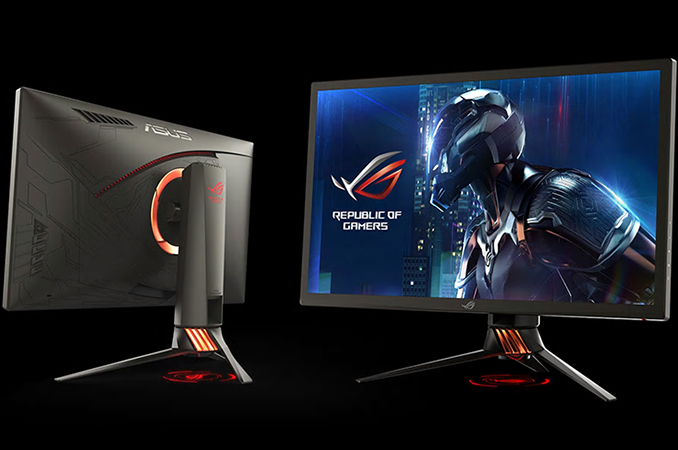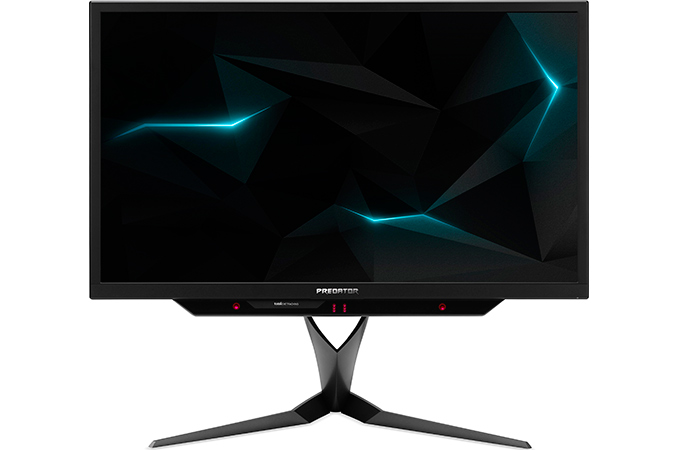NVIDIA Expects 4K 144 Hz G-Sync HDR Displays to Launch in April
by Anton Shilov on March 21, 2018 6:35 PM EST- Posted in
- Monitors
- Displays
- Acer
- Asus
- NVIDIA
- Predator X27
- ROG Swift PG27UQ
- G-Sync HDR

Acer and ASUS unveiled their prototype 27” 4K 144 Hz displays, featuring NVIDIA’s G-Sync HDR technology, at last year’s CES, with promises to release them sometime later in 2017. Both monitors relied on a reference design developed by NVIDIA and had similar specifications, albeit with some minor differences. Eventually, both companies had to delay commercial launches of their new products to 2018, missing the important holiday sales season. This week at GDC, NVIDIA has stated that it is confident that the G-Sync HDR-compatible displays will hit the market this April.
Both the Acer Predator X27 and the ASUS ROG Swift PG27UQ are implementations of NVIDIA’s reference design for G-Sync HDR displays: they offer a 3840×2160 resolution, a 144 Hz refresh rate, a 1000-nits brightness, a direct LED backlighting system with 384 zones, and feature a quantum dot film to enable HDR10 and coverage of the DCI-P3 color gamut. The monitors announced last year were to be based on AU Optronics’ M270QAN02.2 AHVA panel, which was the only one to support the combination of features that NVIDIA wanted for G-Sync HDR displays.
Neither Acer, nor ASUS, disclosed the reasons why they had to delay their ultra-premium gaming monitors from late 2017 to 2018, but given a rather unique feature-set of both displays, a lot of possibilities come to mind: starting from a panel delay by AUO to reference design changes by NVIDIA.
At GDC, NVIDIA has said that G-Sync HDR-supporting displays will finally ship in Q1, but noted that by Q1 it means its fiscal quarter, not calendar quarter. NVIDIA’s Q1 FY2019 (2019 because NV's fiscal year is one year ahead) ends on April 29, 2018, so it is logical to assume that the monitors will ship next month. What remains to be seen is the pricing as well as the final set of features and technologies.
Related Reading
- Acer and ASUS Delay Their 4K 144 Hz G-Sync HDR Displays to 2018
- ASUS Demonstrates ROG Swift PG27UQ: 4K, 144 Hz, HDR, DCI-P3 and G-Sync
- Acer Announces Predator X27 Monitor: 4K@144 Hz with DCI-P3, HDR10, & G-Sync
- Samsung Announces First Freesync 2 Monitors: CHG70 & CHG90 - Quantum Dots, Up to 49”, 144 Hz, DCI-P3
Source: NVIDIA











61 Comments
View All Comments
nevcairiel - Thursday, March 22, 2018 - link
Its important to note that a Titan V is not a gaming card though. The architecture between gaming-focused chips like the GP102,104,etc is distinctly different to the compute-focused chips like the GP100 or GV100.So basically, a full gaming Volta (the x80 Ti variant of that line) would quite possibly exceed the Titan V in gaming performance.
DanNeely - Thursday, March 22, 2018 - link
If the die was the same size a pure GFX volta'd be a lot faster; but even for a GPU GV100's enormous; I'd expect the gaming focused GV102/104 to dump most of the compute only hardware to shrink the die size while keeping the core count about the same (the ~50% in GV100 is about right for a generational upgrade). Dropping the compute baggage might let it clock a bit higher but I'd expect performance to stay in the same general ballpark; just be a lot cheaper. (Assuming the miners don't ruin it anyway.)rtho782 - Thursday, March 22, 2018 - link
This is very relevent.My desktop monitor is a RoG Swift, 1440p 144hz. I have two 1080tis in SLI.
When games support SLI, great, when they don't, oh well I have GSync and get reasonable performance still.
I also have my computer connected to my TV (a 55" 4k HDR model) for "couch gaming". I basically only use this if a game supports SLI as otherwise it's a mess.
FFXV, I'm looking at you. I either have to drop the settings or accept ~40fps, which means with vsync I'm seeing more like 30fps.
With SLI dying a death, we need much more powerful GPUs before I would run a 4k display as my main display.
imaheadcase - Wednesday, March 21, 2018 - link
Right..its almost like they think people forget that its been announced since June 1, 2017. In fact its been delayed THREE times since then.https://www.anandtech.com/show/11491/acer-asus-unv...
So basicly they are lowering specs. But the kicker here is there the monitors in first article DID get a small release in Japan...for $2000, lol
Sarchasm - Wednesday, March 21, 2018 - link
They were announced at least as far back as CES 2017. Most seasoned vets who track monitor release know to add +15 months from the date of a product's first trade show appearance, especially if it involves AUO.They haven't lowered the specs at all, that I've seen.
imaheadcase - Thursday, March 22, 2018 - link
Yes they did, look at the link i posted. 27 inch vs 34. 144Hz vs 200Hz.They simply could not mass produce what they wanted to. And honestly 27 inch 4k is totally not worth it.
Spunjji - Thursday, March 22, 2018 - link
Why is it "totally not worth it"?noumuon - Thursday, March 22, 2018 - link
I think you're confused. Your link indicates they showed off 27 inch 144 hz displays and simply announced the higher spec displays. You should try reading a little better.DanNeely - Thursday, March 22, 2018 - link
Yup. The curved 3440x1440 200hz panel is a bit farther down AUO's pipeline. The 27" 4k one has always been their first hundreds of dimming zones HDR model.AUOs 144p 200hz ultrawide along with a 16:9 1440p panel at 240hz is 18Q2, with a 32" 4k 144hz in Q3. They've got a few other panels in flight as well; but those're the ones of most interest to gamers.
http://www.tftcentral.co.uk/news_archive/38.htm#au...
Birb Person - Wednesday, March 21, 2018 - link
They haven't lowered the specs at all.